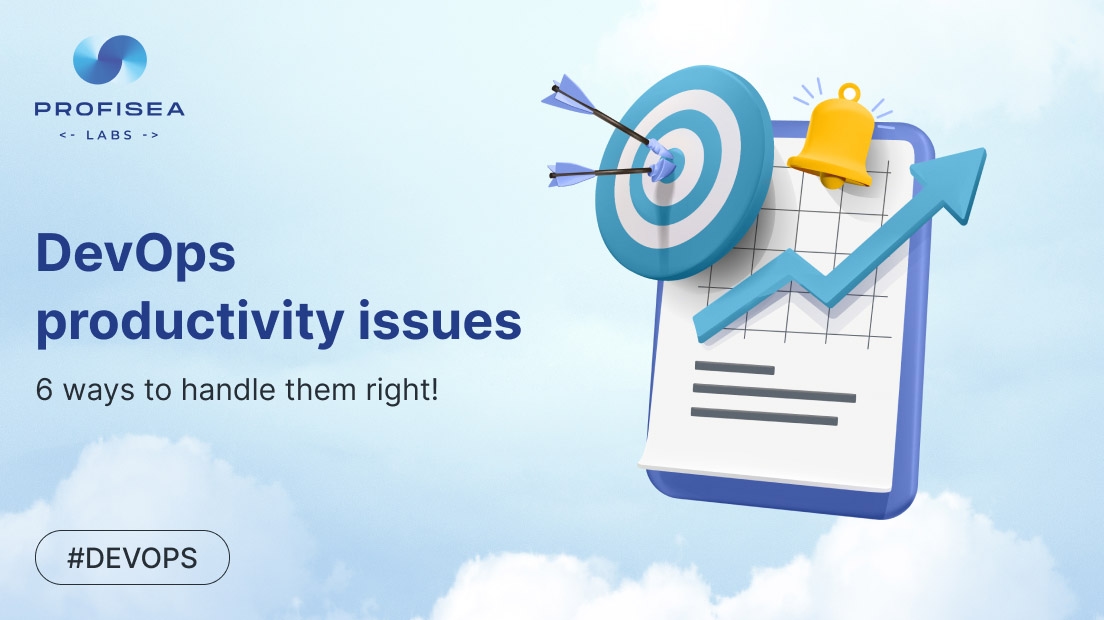DevOps productivity issues: 6 ways to handle them right!

DevOps started 11 years ago and has grown in popularity ever since. While experts explain DevOps differently, one way or another, everyone should agree that DevOps is about streamlining software delivery processes to produce high-quality, customer-centric products more swiftly. According to Atlassian's study of 500 developers and CIOs, 99% of respondents said DevOps had a positive impact on their organization by improving product/service quality, time-to-market, and team productivity. This is why many IT companies are eager to implement DevOps in their teams and are looking for an easy way to do so. Atlassian's survey of 750 IT executives and engineers found that while 83% of respondents agree that interagency collaboration is critical to successful software development, only 41% of respondents consider cross-collaboration a priority. From lack of coordination among team members and fragmented automation tools to lack of visibility and poor performance testing – DevOps teams need to address several critical issues to ensure their optimal performance.
How DevOps hastens software delivery, cuts costs, and helps build a productive team
In today's digital world, Usain Bolt-fast delivering high-performance products is a cornerstone objective, and all businesses are working hard to improve software manufacturing processes using innovative platforms and methodologies to meet growing customer expectations. This is where DevOps comes in, speeding up the delivery of high-quality products by advancing partnerships between pivotal teams. With DevOps, teams become more productive, enabling businesses to produce more, improve quality, and save money. According to the State of DevOps Report, elite companies that have 973x more frequent deployment, 6570x (no kidding) faster lead time from committing to deploying, and 3x lower change rate failure are using DevOps. Do you need more proof? Here are DevOps benefits:
- Swift software delivery. By using the right DevOps practices, companies are rapidly creating new, high-quality, customer-centric products and features.
- Process automation. With DevOps, processes are fully automated, which reduces fatigue and reduces disruption.
- Effective collaboration. The software development process becomes more transparent with DevOps, allowing teams to collaborate effectively, which dramatically improves their productivity.

What’re the issues with DevOps team productivity and how to resolve them
Below we explain the common challenges faced by DevOps teams and the corresponding solutions we can prescribe.
Projects and DevOps do not match
It’s hard to fight the temptation to apply DevOps to all new projects, but it may not work. Incorrectly implemented DevOps can actually stall the processes and take a lot of deployment time. This is why you need to be very selective about your DevOps projects. A clean DevOps implementation would be the wrong strategy. Do you want to quickly scale new software without bumping into blockages and slide processes? Well, in this case, DevOps might be a perfect choice. But you shouldn't use DevOps as a solution to all sorts of operational problems in your project. If you are using an older system and need multiple updates and upgrades to support DevOps, the old method may be more efficient.
Piecemeal, Siloed Automation
Scattered automation elements are not uncommon in DevOps development environments, even though the DevOps culture is inherently anti-siloed. DevOps cannot be implemented by adopting two / three tools that automate some SDLC phases having others handled manually. Plus, companies that use separate tools to automate processes often create automation gaps that, in fact, slow down DevOps, not to mention a myriad of compliance issues. Companies need to manage change with complete, responsive management tools to control all phases of projects. That is why, to ensure maximum productivity, attention must be paid to professional automation systems like efficient DevOps platforms that effectively automate your production environment allowing you to manage the infrastructure independently.
Lack of Visibility
It’s not a secret that the DevOps approach's effective implementation goes hand-in-hand with infrastructure's massive migration to the clouds. According to a PwC report, 75% of IT decision-makers are considering turning to the cloud’s adjustable and scalable services. However, with great flexibility also comes a new set of challenges such as the complexity of managing and security. So, understanding the infrastructure's current state, automated planning of the future steps, fast troubleshooting, easily triggered scaling-up/down, and supervised security can be carried out with the help of cloud visualization. Nowadays, you have specific cloud management platforms that help DevOps, security engineers, analysts, and IT leaders to control cloud environments, generate cloud environment diagrams automatically and manage all existing instances and dependencies for cost-effective performance. Plus, you don’t have to be a cloud expert to become a visualization professional and start optimizing your cloud architecture today.
Ambiguous Performance Metrics
Before you think of starting DevOps decide which DevOps metrics you need to monitor more actively to improve the software delivery process.
Here are the critical DevOps metrics
- Deployment frequency. The golden rule is smaller deployments as often as possible. With fewer deployments, software testing and deployment are much more convenient.
- Deployment time. While it may seem inconsequential at first, measuring deployment time is one DevOps metric that can indicate potential problems. For example, if the deployment takes an hour, something is wrong.
- Successful automated tests percentage. Since DevOps relies heavily on automation, a useful DevOps metric is measuring how well-automated tests perform. It is useful to know how many code corrections are causing the tests to fail.
- Code commits number. This serves as a measure of both development speed and code accuracy. The team must come up with a standard set of code commits that each team member must follow.
- Expenses. You should focus on unnecessary costs and try to reduce them. Visualizing the sources of your spending can go a long way in understanding the activities you pay the most. The ideal scenario would be to use a professional cost-optimization platform that can help with environment visualization and automate sleep cycles to wake up the environment only when you actually use them to cut costs.
- 3 Mean-time metrics: Mean Time To Failure / to Detection/ to Recovery are a must for effective application monitoring and dealing with failures.
- Lead time. An important metric for measuring workflow and efficiency is an estimate of the average time it takes for a project to go from concept to implementation.
Burnout problem
A new Survation report found that 83% of developers and DevOps professionals experience burnout, largely due to the pandemic. Indeed, about 55% of specialists said they have burnout wavering from moderate to severe, while only 17% said they were not suffering from one. Most blamed the pandemic for an increased workload and general anxiety. The report says the workload has increased due to more digitization as every business has been forced to go online due to the lockdown. What's more, it has been found that burnout can be related to cycle time, which is how quickly a team of engineers can put ideas into production to get feedback from real users. So short cycle times mean highly productive developers. Burnout tends to happen when teams accomplish lots of manual repetitive tasks without witnessing any progress. To reduce burnout use proficient solutions like production environment management platforms, and excellent management practices such as good communication, refraining from overtime, and ensuring that everyone has time-outs.
Work-life disbalance
Work-life balance is all about how people adjust their time and exertion between professional and personal commitments. A healthy work-life balance is not a luxury but an obligation for any person’s overall well-being designed to lessen stress levels and the risk of creative congestion. In terms of the DevOps engineer role, given organizations spend plenty of resources searching, hiring, onboarding, and supporting DevOps experts, sometimes they want the latter to perform some magic immediately and work extra hours before they do. So, if Elon Mask’s extraordinary a**-kicking leadership approach might not be your thing, you might consider these work-balance tips:
- Establish strict work hours + switch on a “Being There” effect. Work during specific work hours. The thing is these hours should be effective and for them to be effective, try to be there.
- Set clear and achievable goals. DevOps goals and performance metrics should be clear and realistic.
- Focus and prioritization. We cannot do everything at once. You have to choose the main tasks and focus on them first.
- Proper time-management. Every day planning is a must. Plus, good time/team management tools in hand help operate tasks and visualize the whole picture.
- Fight procrastination and welcome imperfection. Procrastination happens when people are afraid to make a mistake and subconsciously try to avoid assignments that might lead to imperfection. When we accept the fact that mistakes just happen, and more importantly leaders put up that even experienced experts, no matter what role and salary levels are, can miscalculate, procrastination will not happen.
- Switch and have rest. Breaks are important – really overused phrase but so true. Choose your way to relax and just let yourself and your people have some rest from time to time.
- Schedule your non-working hours. It might sound odd, but personal time also needs planning otherwise you’ll find yourself scrolling the newsfeed for five hours in a row instead of having quality time with your family and friends.

Wrapping things up
The goal of DevOps is to foster coordination and collaboration between developers and IT operations teams in a way that maintains fast application execution while minimizing downtime, delays, and issues that negatively impact the end-user experience. Performance is another driving force behind the huge popularity of DevOps. IT organizations are tired of silos and conflicts between developers and IT operation specialists that simply lead to wasted time, and poor technology. But while DevOps has driven to more innovation and smoother, less disruptive workflows, a couple of things still stand in the way of unlocking the full productivity potential of DevOps: amateur cloud management, fuzzy metrics, lack of automation, and more. In this article, we tell how you can address these concerns utilizing an expert DevOps platform and handle DevOps productivity issues aptly. If you have any DevOps / CloudOps-joint questions, please don’t hesitate to contact us for a free consultation.